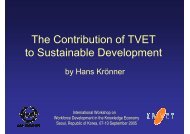Learning for Life, Work and the Future Initial ... - Unesco-Unevoc
Learning for Life, Work and the Future Initial ... - Unesco-Unevoc
Learning for Life, Work and the Future Initial ... - Unesco-Unevoc
You also want an ePaper? Increase the reach of your titles
YUMPU automatically turns print PDFs into web optimized ePapers that Google loves.
Page 58 Participants’ Papers <strong>Learning</strong> <strong>for</strong> <strong>Life</strong>, <strong>Work</strong> <strong>and</strong> <strong>the</strong> <strong>Future</strong><br />
constant skills enhancement is necessary <strong>for</strong> those<br />
wishing to succeed <strong>and</strong> remain marketable.<br />
2. Innovative Use of Facilities <strong>and</strong> Equipment<br />
The enormous growth in part-time training shows that<br />
people are becoming aware that in order to increase<br />
<strong>the</strong>ir marketability <strong>the</strong>y have to augment <strong>the</strong>ir skills in<br />
line with current job requirements <strong>and</strong> future trends.<br />
Cumulative experience of recent years suggests that<br />
many of <strong>the</strong> development strategies pursued by<br />
developing countries have failed to produce <strong>the</strong> kind of<br />
results that were hoped <strong>for</strong> by planners <strong>and</strong> policy<br />
makers. In particular, mounting unemployment among<br />
young people has emerged as one of <strong>the</strong> most<br />
intractable problems at a time when virtually all<br />
countries are striving to exp<strong>and</strong> <strong>the</strong>ir education<br />
systems: reorientation of schooling to integrate <strong>and</strong><br />
give emphasis to technical <strong>and</strong> vocational education<br />
may well be justified, but is unlikely to lead directly to<br />
<strong>the</strong> creation of new jobs.<br />
2.1 Cost-effective solutions <strong>for</strong> design, construction<br />
<strong>and</strong> use of facilities<br />
Successful individuals possess certain characteristics<br />
that distinguish <strong>the</strong>m from <strong>the</strong> rest of <strong>the</strong> crowd.<br />
Successful individuals are goal-orientated; <strong>the</strong>y have a<br />
clear concept of what <strong>the</strong>y want <strong>and</strong> how to get it; <strong>the</strong>y<br />
are self-motivated <strong>and</strong> can work independently with<br />
little or no supervision; <strong>the</strong>y can adapt to new<br />
situations, seeing change as an opportunity instead of a<br />
threat; <strong>the</strong>y are willing to learn <strong>and</strong> thrive on<br />
development.<br />
Securing an effective national response to <strong>the</strong> problems<br />
of organizing TVET is often difficult because of <strong>the</strong><br />
involvement of a multiplicity of agencies (government<br />
ministries, donor communities, churches <strong>and</strong> NGOs,<br />
etc). Economists <strong>and</strong> human resource planners, private<br />
sector employers, representatives from <strong>the</strong> public<br />
service <strong>and</strong> officials from o<strong>the</strong>r ministries are just as<br />
likely to be involved as educational policy makers <strong>and</strong><br />
planners. In addition, national ideologies, historical<br />
antecedents, social, economic <strong>and</strong> cultural factors are<br />
also powerful variables in <strong>the</strong> different approaches to<br />
TVET planning <strong>and</strong> provision.<br />
A review of <strong>the</strong> resource inputs over <strong>the</strong> period (1991<br />
to 2000) portrays a ra<strong>the</strong>r gloomy picture of programme<br />
per<strong>for</strong>mance.<br />
To be effective, policies <strong>for</strong> educational re<strong>for</strong>m aimed<br />
at minimising unemployment <strong>and</strong> improving links<br />
between work <strong>and</strong> school must be considered in<br />
conjunction with policies <strong>for</strong> additional employment<br />
opportunities <strong>and</strong> <strong>for</strong> modifying current labour market<br />
practices. In many respects, issues affecting <strong>the</strong><br />
planning of TVET cannot easily be separated from<br />
those affecting planning of education as a whole,<br />
especially with regard to <strong>the</strong> significance that needs to<br />
be attached to <strong>the</strong> clarification of aims <strong>and</strong> purposes.<br />
3. Range <strong>and</strong> Flexibility of Programmes to Suit All<br />
Target Groups<br />
The programmes must be “sold” to <strong>the</strong> community as<br />
being worthwhile, not second-rate, simply because<br />
<strong>the</strong>y are delivered in a non-traditional way.<br />
Three characteristics distinguish TVET from o<strong>the</strong>r<br />
<strong>for</strong>ms of educational provision. Firstly, most <strong>for</strong>ms of<br />
TVET are assumed to have strong associations with <strong>the</strong><br />
labour market <strong>and</strong> with life after school: though it may<br />
not lead directly to economic growth, it is widely<br />
regarded as playing a key role in easing <strong>the</strong> transition<br />
from school to work <strong>and</strong> enabling young people to<br />
acquire employment-related skills. Secondly, <strong>the</strong><br />
modern sector depends more <strong>and</strong> more on knowledge<br />
<strong>and</strong> underst<strong>and</strong>ing derived from developments in<br />
science <strong>and</strong> technology, which has made it essential <strong>for</strong><br />
elements of applied science, craft practice, <strong>and</strong> technology<br />
to <strong>for</strong>m part of general education, apart from<br />
<strong>the</strong> need to encourage educational experiences relating<br />
more specifically to <strong>the</strong> world of work. Finally, from<br />
<strong>the</strong> planning point of view, <strong>the</strong>re are questions about<br />
when, where <strong>and</strong> how technical subjects <strong>and</strong> vocational<br />
skills should be taught.<br />
4. How <strong>the</strong> Relevance of Programmes to <strong>the</strong> Local<br />
Economy is Ensured<br />
Providers must ensure that TVET learning materials<br />
are appropriate to <strong>the</strong> target groups, <strong>and</strong> that <strong>the</strong> skills<br />
<strong>and</strong> competencies learned are those required by<br />
occupational groups <strong>and</strong> appreciated by employers.<br />
The courses must have an accreditation that is<br />
acceptable by both enterprises <strong>and</strong> o<strong>the</strong>r educational<br />
institutions.<br />
Without underestimating <strong>the</strong> importance of seeking<br />
policies, criteria, techniques <strong>and</strong> procedures to enable<br />
administrators of education systems to carry out <strong>the</strong>ir<br />
tasks more effectively, I believe that <strong>the</strong> most acute<br />
problem arises from confusion about <strong>the</strong> nature,<br />
purpose <strong>and</strong> relevance of education. TVET is characterised<br />
by features that pose problems <strong>for</strong> policymakers<br />
<strong>and</strong> educational planners, in terms of locating<br />
provision within both appropriate objectives <strong>and</strong><br />
appropriate structures, overcoming constraints associated<br />
with high recurrent <strong>and</strong> capital costs, <strong>and</strong><br />
nurturing effective management practices.<br />
5. Conclusion<br />
The Government <strong>and</strong> people of Lesotho recognise <strong>the</strong><br />
enormity of <strong>the</strong> task of addressing competently <strong>the</strong><br />
challenges of access, quality, relevance <strong>and</strong> capacity<br />
building in education. There is adequate appreciation<br />
of <strong>the</strong> necessity to work in concert <strong>and</strong> collaboratively<br />
with <strong>the</strong> world community to address <strong>the</strong>se challenges.





